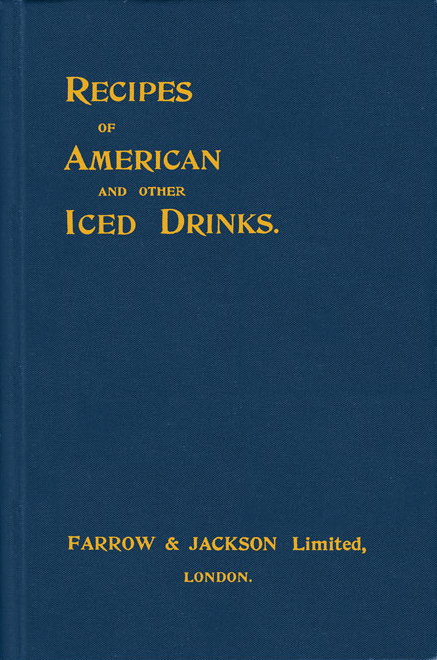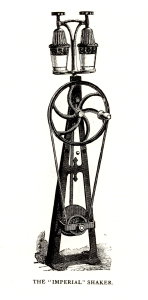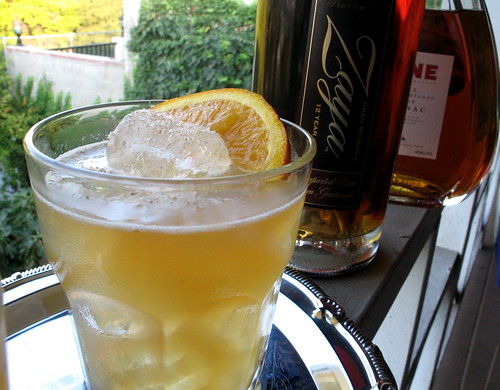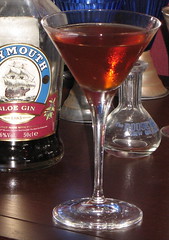Mixology Monday XXXI: 19th Century Cocktails
Yeesh, talk about barely making it in under the wire (once again). I wasn’t supposed to be in town, actually, and was far too disorganized to do it in advance and have the post ready to go. Mainly that was because I was schvitzing about Hurricane Ike heading directly toward Houston, which is where I was supposed to be going to see my sister, brother-in-law, fabulous nephew Thomas and fabulous brand-new niece Molly, whom I haven’t even met yet. We were supposed to go last Friday, but on Thursday they bugged out … to New Orleans, of all places, not where you usually think of going to get away from a hurricane. All’s well for them, though — they had a tree go down in their front yard in Houston, but no damage to the house. (They were far luckier than all those poor folks in Galveston, good lord.)
And it’s not like we haven’t been drinking all weekend either — delicious yet deadly punches by Marcos Tello and Eric Alperin on Thursday, courtesy of the House of Chambord (I’ll see if I can pry the recipes out of them) and a big fat hangover on Sunday. It finally occured to me this morning that if I was going to get a post up today I needed to get my butt in gear. Fortunately I’d been doing some reading right along the lines of what we were going to be doing this month.
 A wonderful company called Mud Puddle Books has been releasing several once-extremely difficult to find cocktail books from the 19th and early 20th Centuries, books which otherwise might have set you back hundreds of dollars. It’s wonderful — and essential — that these books are back in print, because for cocktailians they are a big part of our history. We want to know where all this stuff came from, and while there has been extensive research, and we have Jerry Thomas’ and others’ books, there were several key volumes of cocktail history that were only available to collectors who either had deep pockets or were just lucky enough to get them before there was a demand.
A wonderful company called Mud Puddle Books has been releasing several once-extremely difficult to find cocktail books from the 19th and early 20th Centuries, books which otherwise might have set you back hundreds of dollars. It’s wonderful — and essential — that these books are back in print, because for cocktailians they are a big part of our history. We want to know where all this stuff came from, and while there has been extensive research, and we have Jerry Thomas’ and others’ books, there were several key volumes of cocktail history that were only available to collectors who either had deep pockets or were just lucky enough to get them before there was a demand.
I’ve got everything they’ve put out so far, and I’ve been devouring them with glee. Besides being informative, they’re beautifully done — in the original typefaces, and with original illustrations and period advertisements — they’re damned entertaining too. There are also new introductions by the likes of David Wondrich, Ted “Dr. Cocktail” Haigh, Robert Hess and Dale DeGroff. The one I’ve been reading this week is Charlie Paul’s 1902 edition entitled Recipes of American and Other Iced Drinks.

Dale wrote the introduction to this one, and although it was published in 1902 it gives a pretty amazing look at the state of drinking at the end of the 19th Century. Such a terrific little book too; besides all the recipes (including some startling variations on drinks we now consider standards, like the Manhattan and Mint Julep) the illustrations alone are worth the price of the book. Dale says, “The illustrations of 19th Century bar tools were extraordinary; a few of which I’ve  since seen reproduced in some modern texts. The illustration depicting the Imperial Shaker was enough to make me want to search the world for this wonderful drink-cranking device and build an entire bar around it.” That would be it to the right; click to enlarge.
since seen reproduced in some modern texts. The illustration depicting the Imperial Shaker was enough to make me want to search the world for this wonderful drink-cranking device and build an entire bar around it.” That would be it to the right; click to enlarge.
Now, what to pick? There are so many I wanted to try, including ones with a pinch of cayenne pepper (with and without egg), a pousse-café topped with an egg yolk and then a “pyramid” of whipped egg white, topped with dashes of bitters (which I’m definitely going to try). I would have done that wonderful Mint Julep variation. which includes brandy, rum, yello Chartreuse and which is dashed with Claret on top of the ice, which Charlie describes as “a drink fit for a king.” Then there were a few like these, which I thought maybe I’d skip:
AMMONIA COCKTAIL
(Good Morning Tonic for Headache)Draw 2 ounces of Orange Syrup into a 12-ounce glass and add 1/2 drachm of Aromatic Spirits of Ammonia; about half fill the glass with Soda Water, then add half teaspoonful of Bi-carbonate of Soda. Stir well and handle quickly. ( This Cocktail should be drunk at once.)
“Handle quickly”? What, before it blows up? No, I took a pass on this one.
I really wanted to make something with Old Tom gin. I had gotten a chance to taste some of the batch Eric brought into town with his distributor (currently available at Hi Time Wine and Spirits in Costa Mesa, far enough that it might as well be in Kazakhstan, with more due soon at my local haunts, Beverage Warehouse and The Wine House) last Tuesday at Seven Grand. Just as tasty as I remembered it, and John made us a lovely 19th Century-style Martinez with it. But I didn’t have any on had, so nix that.
What I thought I’d do is a punch. Punch was the mixed drink of choice for a very long time, and was beginning to be displaced by all the cocktails, fixes, flips, fizzes, daisies, sangarees, slings and other mixed drinks that were invented by the scores in the 19th Century, but by this time punch was still holding on. There were some good-looking recipes in there, but I wasn’t particularly inclined to make a whole bowlful of it. (Not that I couldn’t get several friends over at a moment’s notice to help us drain the flowing bowl, but I was lazy.) I came across one by-the-glass punch recipe that looked simple and tasty, and filled the bill on both counts.
This fits in with the basic formula for punch, as David Wondrich described to us in his terrific seminar on punch at Tales (which I’ll recap one of these days). It’s essentially wine or booze, citrus, soda or water, sugar and some kind of wild card (berries, tea, spices, etc.). It’s easy to make, refreshing during these waning days of summer and was pretty damned tasty.

Java Punch
Fill tumbler with chipped ice; put in half a teaspoonful of powdered sugar, a teaspoonful of vanilla syrup; squeeze half a lemon in; add a liqueur-glassful of brandy and the same of rum; shake well and strain off, putting an orange slice on top.
Or, in slightly more modern measure:
1 ounce brandy.
1 ounce rum.
3/4 ounce fresh lemon juice.
1 teaspoon vanilla syrup.
1/2 teaspoon simple syrup.
Nutmeg.
Orange slice.Combine liquors and syrups in a shaker with ice; shake until very cold and frothy. Strain over fresh ice into an Old Fashioned glass. Top with a grating of fresh nutmeg and garnish with an orange slice.
Charlie’s original recipe didn’t call for nutmeg, but as many 19th Century and earlier punches were finished that way, I added that to the top for a nice aroma and one more “wild card” dimension to the flavor. The recipe is easily adaptable to your own taste; if you like it tarter, up the lemon to 1 ounce, or if you like it sweeter maybe an extra half-teaspoon simple syrup. I think the vanilla flavor is in perfect balance with just the one teaspoon of vanilla syrup, though. The brandy I used was Hine VSOP Cognac, the rum a 12 year old Guatemalan called Zaya, which sadly is going away soon and will no longer be available. (I was feeling extravagant.)
Pass the punch!
P.S. — Okay, so as I’m about to post my MxMo entry at Bibulo.us, I see this little bit at the end of the post: “Bonus points to anyone who can bring us early William “Cocktail” Boothby recipes, especially pre-1900 versions of the Ruby Cocktail.”
Well, I had just gotten in a reproduction of the 1934 version of Boothby’s World Drinks and How To Mix Them. I really hadn’t gone through it that much yet, but I found myself shifting into the mode that caused one of my chef-teachers in the UCLA Culinary Arts program to dub me “The Overachiever.” (She may have been five feet tall in heels, but she kicked my ass every single class. She was amazing, actually. But I digress.)
I found The Ruby Cocktail with two additional variations, the second containing gin (which I thought would help dampen the sweetness of sloe gin, the primary ingredient) and the third containing egg. I’m out of eggs, so No. 2 it was.
The Ruby Cocktail No. 2
1/2 ounce sloe gin.
1/2 ounce gin.
1/4 ounce sweet vermouth.
1/4 ounce dry vermouth.
2 dashes Bénédictine.Shake with ice and strain into a small cocktail glass.
This makes a nice li’l 2-ounce drink.
I was a little less than impressed at first, but as I sipped it continued to grow on me. The gin and dry vermouth help dilute the sweetness of the sloe gin, and you get just a touch of herbs from the dashes of the liqueur. Not usually the balance I’m looking for in a drink, but not bad. I kinda want to try the egg white version now.
Okay, enough with the overachieving …






